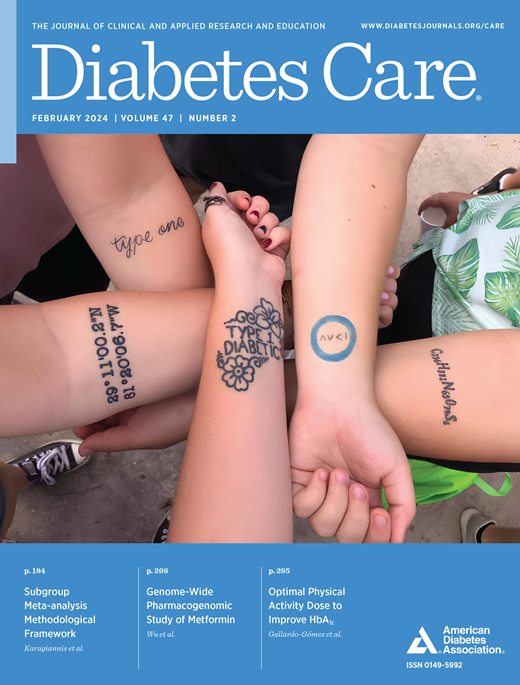Isolated Glucosuria in Adolescence and Early-Onset Diabetes: A Nationwide Cohort Study of 1.6 Million Adolescents
IF 16.6
1区 医学
Q1 ENDOCRINOLOGY & METABOLISM
引用次数: 0
Abstract
OBJECTIVE We assess diabetes risk in adulthood among adolescents with isolated glucosuria. RESEARCH DESIGN AND METHODS Included were adolescents (16–19 years) examined before military service between 1993 and 2015. Data were linked with the Israeli National Diabetes Registry. Glucosuria was confirmed following normal renal function and glucose tolerance tests. Cox models were applied. RESULTS The study included 1,611,467 adolescents, of whom 755 (0.05%) had glucosuria. The latter group had a higher proportion of males (75% vs. 57%) and a lower proportion of BMI ≥ 85th percentile (10.4% vs. 16.3%) compared with nonglucosuric (all P < 0.001). During follow-up, 10,328 diabetes cases were recorded with an incidence rate of 87.5 and 43.3 per 100,000 person-years for those with versus without glucosuria, respectively. Individuals with glucosuria had an adjusted hazard ratio of 2.17 (95% CI, 1.17–4.04) for diabetes. CONCLUSIONS Glucosuria in adolescents is associated with an increased risk of early-onset diabetes.青少年孤立性血糖和早发性糖尿病:160万青少年的全国队列研究
目的:评估孤立性高血糖的青少年成年期糖尿病风险。研究设计和方法纳入1993年至2015年服兵役前的青少年(16-19岁)。数据与以色列国家糖尿病登记处相关联。在肾功能和葡萄糖耐量试验正常后确诊为血糖升高。采用Cox模型。结果该研究纳入1,611,467名青少年,其中755名(0.05%)患有血糖。与非血糖组相比,后者的男性比例更高(75% vs. 57%), BMI≥85百分位数的比例更低(10.4% vs. 16.3%)。0.001)。在随访期间,记录了10,328例糖尿病病例,糖尿病患者与非糖尿病患者的发病率分别为87.5和43.3 / 10万人/年。患有高血糖的个体患糖尿病的校正危险比为2.17 (95% CI, 1.17-4.04)。结论:青少年血糖升高与早发性糖尿病风险增加相关。
本文章由计算机程序翻译,如有差异,请以英文原文为准。
求助全文
约1分钟内获得全文
求助全文
来源期刊

Diabetes Care
医学-内分泌学与代谢
CiteScore
27.80
自引率
4.90%
发文量
449
审稿时长
1 months
期刊介绍:
The journal's overarching mission can be captured by the simple word "Care," reflecting its commitment to enhancing patient well-being. Diabetes Care aims to support better patient care by addressing the comprehensive needs of healthcare professionals dedicated to managing diabetes.
Diabetes Care serves as a valuable resource for healthcare practitioners, aiming to advance knowledge, foster research, and improve diabetes management. The journal publishes original research across various categories, including Clinical Care, Education, Nutrition, Psychosocial Research, Epidemiology, Health Services Research, Emerging Treatments and Technologies, Pathophysiology, Complications, and Cardiovascular and Metabolic Risk. Additionally, Diabetes Care features ADA statements, consensus reports, review articles, letters to the editor, and health/medical news, appealing to a diverse audience of physicians, researchers, psychologists, educators, and other healthcare professionals.
 求助内容:
求助内容: 应助结果提醒方式:
应助结果提醒方式:


